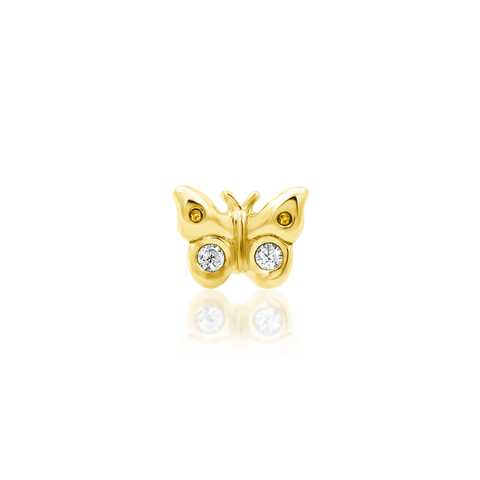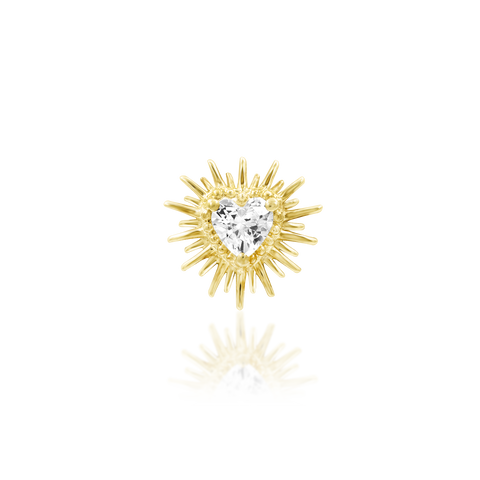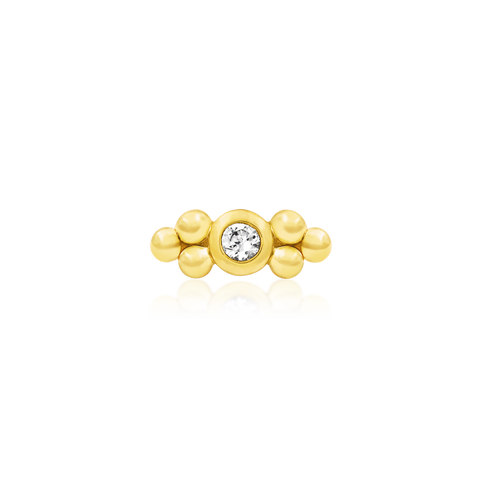Traditional Jewelry FAQ
Get all the answers you need about our Traditional Jewelry line Junipurr For You.
Summary:
- Gold vermeil complete guide
- Solid gold complete guide
- Do you have a warranty?
- Do you have a return policy?
- How will pre-ordering work?
- How long does it take to ship?
- Where do we ship to?
- How do I take care of my jewelry?
- How do I determine my ring size?
- How is Junipurr reducing its carbon footprint?
- Can piercers buy Junipurr traditional jewelry to stock in their studios?
Gold vermeil complete guide
Gold vermeil (pronounced vehr-may; it's French!) has some key elements that make it distinctive and superior to common gold plating. Vermeil is a technique originating in the 19th century and a legally regulated term that refers to high-quality gold-plated jewelry. To be legally called "vermeil" in the United States, the jewelry piece must meet ALL of these conditions:
- Have sterling silver as its base material. Sterling silver is an alloy made of 92.5% pure silver and 7.5% other materials and is a standard material used in high-quality jewelry (versus, e.g., brass or copper).
- It must be plated in a gold layer that is at least 10k (10 karats), which means the gold has at least 41.7% gold content.
- Have gold plating that is at least 2.5 microns thick. A micron is 1/1000th of a millimetre.
Yes, the gold used in vermeil is real gold. At Junipurr, we use 14k gold for our gold vermeil layer.
Due to its thicker gold layer, gold vermeil is a durable option for jewelry pieces. Taking proper care of your favourite pieces, like necklaces and bracelets, will ensure your pieces stand the test of time. There are numerous ways to care for your jewellery, from keeping it clean to keeping it away from liquids and even storing it in its own pouch rather than thrown in with other pieces.
Gold vermeil is not the same as gold-plated jewelry. The main differences between gold vermeil and gold-plated jewelry are the thickness of the gold plating and the base metal used. Gold-plated jewelry has plating at least 0.5 microns thick (5x less than gold vermeil). It does not require a sterling silver base; it usually uses inexpensive materials, such as copper or brass, as its core metal. Since the layer of gold is so thin, the gold plating tends to wear off very quickly, which can cause the jewelry to degrade at a faster speed.
Gold vermeil is a legally regulated term that refers to jewelry with a sterling silver base metal and a layer of gold plating at least 2.5 microns thick. Gold vermeil is superior to gold-plated jewelry in terms of longevity, quality and value!
14k gold vermeil is jewelry that has been plated with a thick layer of 14k gold over a sterling silver base. 14k gold is composed of 58.3% pure gold and 41.7% other metals. Jewelry makers prefer 14k gold for the outer plating rather than 100% pure gold (aka 24k gold) because pure gold is very malleable and has very strong yellow and orange tones, which give it a brassy look.
After solid gold, gold vermeil is the highest quality type of gold tone jewelry that you can buy. It is a great option for those who are seeking an affordable and high quality alternative to solid gold jewelry.
Gold vermeil jewelry uses a thick layer of gold plating over a sterling silver base, while cheap gold-plated and gold-filled jewelry uses a thin layer of gold over brass or copper as their base metals. They are susceptible to tarnish, and the thin layer of gold will wear off quickly, leaving the unattractive metal to show through.
If you are looking for a sustainable option for jewelry but cannot afford solid gold, gold vermeil is your next best choice.
In short, yes—unfortunately, gold vermeil can wear off after heavy use; however, because it is so thick, the plating layer can last for many years with proper care.
While gold vermeil is considered resistant and durable, like all alloyed gold, with typical wear and use, the metal can naturally start to fade over time… but don’t expect this to happen anytime soon.
Gold vermeil can tarnish, but tarnishing can be prevented with good care. Tarnishing occurs in jewelry when various metals chemically react with air or moisture, resulting in the formation of copper dioxide (a brown or black colouration on the surface). Environmental factors such as humidity, sweat, lotions, and perfumes can increase the likelihood of tarnishing.
Gold vermeil has sterling silver at its core, and thankfully this is much less susceptible to tarnish than copper-based jewelry, brass-based jewelry and jewelry that contains nickel.
Tarnish can easily be polished off, and you can bring jewelry back to its original shiny form.
Gold vermeil can get wet, but we don’t call it waterproof because it’s not advisable to submerge gold vermeil jewelry in water for long periods of time. If you want to extend the lifespan of your jewelry, it is recommended that you keep your gold vermeil as dry as possible. While water may not have any immediate devastating effects on gold vermeil, as a result of the continuous chemical reactions that occur over time, this can induce tarnishing or reduce the shine of your jewelry pieces.
There are no metals that are truly considered 100% waterproof (not even solid gold), which is why jewelry care is extremely important for those who want to ensure the longevity of their beloved pieces. As a precaution, it’s important to remove your vermeil pieces before you go to the beach, pool or gym (sweat plays a part too)!
You can shower with your gold vermeil jewelry on, but we don’t recommend making it a habit because it can accelerate tarnishing. An occasional shower will not immediately alter the appearance of your gold vermeil jewelry, but patting the pieces dry immediately afterward is best. Additionally, you should avoid contact with soaps, shampoos and conditioners as the chemicals in these substances may cause tarnish or make your jewelry look dull.
Gold vermeil can be considered hypoallergenic, but it depends on how it has been made. The main metal that causes allergic reactions is nickel, which might be found in the gold plating layer of gold vermeil jewelry if it’s not from a reputable manufacturer. At Junipurr, all of our gold vermeil jewelry is nickel-free and suitable for all skin types.
Solid gold complete guide
14k gold is a gold metal alloy that contains 58.3% pure gold and 41.7% other metals. So, why isn’t gold 100% pure gold? Why 58.3%? Isn’t that kind of a random number? As it turns out, there’s a satisfying explanation.
So, to answer the question, “Why not 100%” gold?: Well, 100% pure gold is a very soft metal (Mohs 2.5), making it extremely easy to scratch and bend, and it’s a bit pricey. Understandably, you might not be inclined to hand over a few thousand dollars for a piece of jewelry that’s probably going to get scratched and bent out of shape.
So, jewelers have come up with a great solution: Gold metal alloy, which is a mixture of gold and other more sturdy metals. As long as a gold-based metal alloy contains at least 41.7% pure gold (that’s 10k), it can be legally labeled and sold as solid gold.
14k gold contains 14 parts pure gold and 10 parts other metals, making it (14 divided by 24) 58.7% pure gold and 41.3% other metals.
Here’s a simple breakdown of standard karats of gold:
- 10 karat: the gold to total material ratio is 10/24 or 41.3/100; this can also be called 413 gold
- 14 karat: the gold to total material ratio is 14/24 or 58.7/100; this can also be called 587 gold
- 18 karat: the gold to total material ratio is 18/24 or 75/100; this can also be called 750 gold
- 24 karat: the gold to total material ratio is 24/24 or 99.9/100; this can also be called 999 gold
The different types of 14k gold refer to the different colors that the gold can be made into by alloying it with other metals. The most common types of 14k gold are 14k white gold, 14k yellow gold and 14k rose gold:
- 14k white gold is created by alloying pure gold with white metals such as silver or palladium, giving the gold a silvery-white appearance.
- 14k yellow gold, on the other hand, is alloyed with copper and silver, which gives it a warm, yellow tone.
- 14k rose gold is created by alloying the gold with copper, which gives it a reddish-pink hue. The specific combination of metals used in the alloying process determines the final color of the gold, allowing for a range of beautiful and unique options.
Yes - 14k gold is real gold, and it can be legally marketed as solid gold! 14k gold is a homogenous mixture of gold and other metals, such as copper, silver, and zinc, used to increase its strength and durability. 14k gold is a first-rate choice for jewelry as it is more affordable than higher karat golds while still having a significant amount of gold content. It is also less likely to scratch compared to higher purity golds.
Yes - 14k solid gold is high-quality and an excellent option for fine jewelry. Its starting prices are much more friendly than higher karat golds; also, its specific proportion of alloyed metals also makes 14k gold less susceptible to wear and tear, ideal for daily use. With a 58.3% pure gold content, 14k gold is intrinsically valuable and befitting of fine jewelry.
Another attraction of 14k gold is its particular hue: some gold jewelry enthusiasts love the soft, warm golden tone particular to 14k. It’s not quite as muted as 10k gold, yet it has a slightly more mature feel than 18k or 24k gold.
14k is (almost literally) the golden average of solid gold alloys when it comes to longevity and durability. Remember, pure gold, while very valuable, is too soft for regular use. 18k (75%) gold retains a good deal of that intrinsic value… and a good deal of the softness too. 10k gold, while definitely the most durable, is, of course, less valuable, and doesn’t have quite the same rich gold colouring.
At just over 50% pure gold, the other “half” of the 14k gold alloy (commonly a mix of copper and silver), gives it a great durability factor and makes it far less likely to scratch or bend. Still, these metals don’t take away too much value, and they give 14k gold an elegant colour. That’s why you’ll often see jewelry designed for everyday use—like a gold wedding band—in 14k gold. With the right care, your favourite 14k solid gold pieces will easily last a lifetime.
With proper care, 14k gold is a heirloom quality precious metal that can be passed down to your loved ones. Of course, factors like exposure to chemicals, harsh cleaning techniques, and physical damage can all affect the lifespan of 14k gold jewelry. So, be sure to store it properly—in a dry place against a soft surface—protect it from sweat and chemicals, and clean it regularly with a soft cloth and mild soap and water (no abrasive materials).
Choosing 14k gold has a host of benefits.
- First, 14k is a valuable precious metal, yet it is much more affordable than higher karat gold alloys such as 18k or 24k. This makes it an attractive option for those who want the look of gold jewelry without breaking the bank.
- 14k gold is also more durable than higher karat gold and still relatively immune to tarnishing, making it optimal for everyday elegant jewelry.
- It is also one of the most readily available karat counts to come in a variety of colours, including yellow gold, white gold, and rose gold.
- Finally, 14k gold is usually hypoallergenic, making it a good option for those with sensitive skin who may have reactions to other metals. Just double-check that it’s nickel-free. Psst… at Linjer, all of our jewelry is hypoallergenic and nickel-free!
Do you have a warranty?
Yes, we stand behind the quality of our jewelry. We offer a 2-year warranty against defects in materials and workmanship.
This means that for 2 years from the date of purchase, we’ll take care of your product if any damage to the material or the workmanship of the jewelry occurs.
We work with top manufacturers to create handcrafted, responsibly sourced pieces that are made to last. We’re confident in the quality of our product hence the 2-year coverage. This also means that the warranty does not cover lost items, scratches that come with normal wear and tear (like a bent ring or broken chain), improper use or storage of your product, and any modification to your product done by a third party outside of Junipurr.
If you need to open a warranty claim, email us at junipurrforyou@junipurrjewelry.com
Important:
- We do not recommend having our products worked on by outside jewelers as this voids any potential for refund or replacement (should a defect develop due to their work). This includes resizing or any type of repair work.
- Please note that in order for us to continue improving, we may require any defective piece to be sent back to us for inspection and quality auditing.
- Promotional products may be excluded from our warranty policy.
Do you have a return policy?
Please see the return guidelines listed below to see if purchased items are eligible for a return. We offer free 30-day returns for all customers. Shipping fees are non-refundable. The return window starts from the day the shipment is delivered/picked up. You are responsible for shipping the item back to us and any associated shipping costs.
To qualify for a return:
- Items must be in their original condition without signs of wear or damage
- Items returned by mail must be in all original packaging (tags, box, and pouch included)
- No individual item of a set can be returned for refund, store credit and/or size exchange, and must be returned as a complete set.
Unfortunately, for hygiene reasons, we cannot refund or replace any earrings.
Items purchased during Pre-Order events are not eligible for returns.
How will pre-ordering work?
Enjoy 20% OFF and be the first to receive our newest collection by placing an order during our pre-order event. The pre-order event will run from July 2nd to July 15th.
Pre-orders are expected to ship in August.
How long does it take to ship?
Pre-orders are expected to ship in August.
Where do we ship to?
We ship to the following countries. Kindly note that we do not ship to PO boxes, parcel lockers, APO, FPO addresses, or freight forwarding companies.
North America
Canada, Puerto Rico, United States of America, Mexico
Europe
Russia, Belarus, Belgium, Czechia, France, Germany, Hungary, Liechtenstein, Luxembourg, Moldova, Monaco, Netherlands, Poland, Romania, Slovakia, Switzerland, Ukraine, Bulgaria, Türkiye,Denmark, Estonia, Finland, Iceland, Ireland, Latvia, Lithuania, Norway, Sweden, Albania, Andorra, Bosnia & Herzegovina, Croatia, Greece, Italy, Malta, Montenegro, North Macedonia, Portugal, San Marino, Serbia, Slovenia, Spain, Lebanon, Cyprus, United Kingdom, Jersey, Guernsey, Isle of Man.
South America
Argentina, Aruba, Brazil, Cayman Islands, Chile, Colombia, Costa Rica, Peru
Oceania
Australia, New Zealand
Asia
Hong Kong, Indonesia, Japan, Malaysia, Philippines, Singapore, South Korea, Taiwan, Thailand, China, Vietnam
Middle East
Qatar, Saudi Arabia, United Arab Emirates, Jordan, Oman, Israel
Africa
Egypt, Morocco, South Africa
How do I take care of my jewelry?
All our jewelry has been made to be well-loved by you. With proper care, it will continue to shine. We’re confident in the quality of our pieces, which is why they come with a two-year warranty in case of any potential defects from the materials or workmanship. Follow our jewelry care instructions to enjoy your jewelry for years to come.
Wearing tips:
- The more intentional you are about caring for your jewelry, the longer it will last.
- Remove your jewelry before doing any activity that risks physical damage.
Storing tips:
- When not being worn, store in a safe, dry place to protect against the elements of daily exposure.
- Store pieces separately to avoid damage.
- Ensure pieces are completely dry before storing.
Cleaning tips:
- Proactive maintenance is the easiest way to care for your jewelry.
- Regularly cleaning your pieces helps to avoid the residue buildup that can dull the original shine.
- To clean with the polishing cloth, gently buff the entire piece until any discoloration or marks are no longer visible.
- To clean with the jewelry care kit, spray the liquid onto the jewelry. Use the brush to remove dirt from finer areas and chains. Dry with a soft, clean cloth and then polish with the cloth provided.
- Ensure pieces are completely dry before storing.
How do I determine my ring size?
You can identify your ring size in two ways: by measuring your existing rings or by measuring your finger. Check out our quick guide to finding your ring size.
How is Junipurr reducing its carbon footprint?
We have teamed up with Ecologi and started a Junipurr forest. Each month, they plant trees on our behalf in our own Junipurr forest, which offsets our employees' entire carbon footprint, including their time spent at work, personal travels, and time outside of work.
We also finance other carbon reduction projects from around the world such as preserving prime Brazilian rainforest and wind energy in India. These initiatives also create employment for local families and restore wildlife habitats.
Check out our Junipurr forest.
Can piercers buy Junipurr traditional jewelry to stock in their studios?
Yes! Junipurr traditional jewelry will be available to piercers at wholesale prices via the Junipurr Piercing jewelry store.


